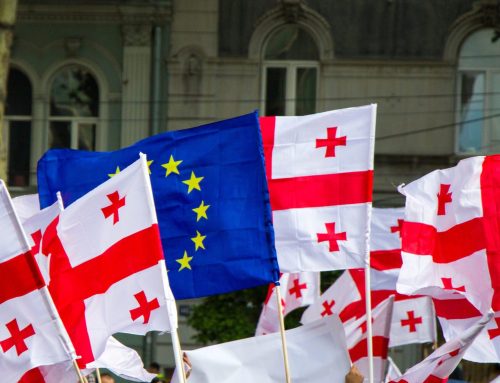The Kremlin and the Chinese Communist Party (CCP), as constant critics of the United States, naturally converge in the information space. The themes and narratives they disseminate about the United States and Western democracies show remarkable consistency—and, at times, appear synchronized. At the end of November 2021, for example, the two countries authored a joint statement challenging the U.S. Summit for Democracy. This trend begs the question: Are Russia and China coordinating information campaigns, or is their symbiotic relationship merely reflective of messaging opportunism and interest alignment?
The Kremlin is the unquestioned leader in the dissemination of global propaganda and disinformation, both on traditional and social media channels. Much of Moscow’s approach has been adopted by Beijing, in both message and method, but the CCP is not copying or borrowing the Kremlin’s playbook outright; China is authoring its own authoritarian influence playbook backed by financial and technological resources that Russia simply cannot match.
An examination of the two countries’ overt propaganda and covert social media influence operations reveals that Russia and China will surely cooperate in smearing the United States, while at the same time pursuing different strategies and long-term objectives in the information space. The two countries demonstrate many similarities in their propaganda and disinformation campaigns, both from a tactical and narrative perspective. Operationally, the Kremlin and CCP have both created a massive network of state-sponsored news outlets that are able to broadcast in many languages around the world. Russia, with RT and Sputnik News, and China, with CTGN, Xinhua, CCTV, and other networks, have created systems of content production that reach millions around the world each day. State-owned propaganda from both countries highlights violence, unrest, and disorder within the United States as a means to criticize Western democracy and the United States’ role on the world stage and to promote their own systems of governance in the process. State media personnel and government officials from both countries also often post misleading or false information targeting the United States. For example, China’s Foreign Ministry spokesman, Zhao Lijian, has embodied China’s “Wolf Warrior” diplomacy, posting disinformation targeting the United States on several occasions, especially regarding the origins of the coronavirus. The recently retired editor of the Global Times, Hu Xijin, has also promoted conspiratorial and confrontational messages on issues ranging from the Hong Kong protests to the treatment of Uyghurs in Xinjiang. This tactic arguably was inspired by Russia, as China only began using Twitter for overt propaganda in late 2019, after the protests in Hong Kong and the global spread of the coronavirus pandemic necessitated a more forceful messaging campaign. Russia’s RT has at times amplified Chinese disinformation, such as Beijing’s allegation that COVID-19 is a U.S. military bioweapon cooked up at its Fort Detrick military base. Both countries also have used the same tactics to disseminate disinformation and spin up conspiracies targeting the United States: In 2014, Russia created an astroturfed online petition campaign to return Alaska back to Russia; in 2021, China used the same tactic to create an illusion of “grassroots” support to investigate Fort Detrick COVID-19 origin conspiracies.
While there are commonalities between Russia and China’s approaches to propaganda and information operations writ-large, there are also differences. Russia’s artful messaging through layered distribution systems of overt media outlets, covert proxy outlets coordinated through their intelligence agencies, and social media manipulators, both overt and covert, deliver tailored messages to target audiences. China, on the other hand, struggles in its development of effective messengers, beyond the Chinese diaspora, that appear like and communicate effectively with Western target audiences; although, the CCP is actively trying to overcome this weakness through the purchase of social media influencers. Instead, China has thus far shown more interest in using synthetic media—computer-generated photos of humans for profile photos in particular—to assist in disinformation operations on Facebook and Twitter as a substitute for recruiting effective messengers inside target audiences.
Russia has steadily and progressively built out its overt messaging operations through the construction of state media outlets around the world, but their proxies often struggle from a lack of investment. The 2020 U.S. election counter malign influence work in the United States revealed the Kremlin hand behind small, flailing outlets like Rebel Inside and infoRos, which were tied to Russian military intelligence (GRU). These outlets distribute inadequate volumes of content with little to no reach inside the target audience.
The scale at which China operates dwarfs Russia’s, both in terms of raw media investments and in terms of content—CCP-aligned “content farms” push out hundreds if not thousands of articles per day. Offline, China has proven much more insidious and effective than Russia in information warfare by outright or de facto acquisition of media outlets. State-owned media outlets that fit into the “Grand Overseas Propaganda Campaign,” in particular Xinhua and CGTN, are making a serious bid to replace Western media outlets as the default wire service throughout Southeast Asia. Cash-strapped outlets in Thailand and Cambodia, for example, have entirely outsourced their COVID-19 coverage to Chinese state-owned media outlets. Finally, China is increasingly amplifying foreign vloggers whose views align with their own, including in the United Kingdom and Israel. Even when money isn’t offered in exchange for interviews on Chinese state-media outlets, the boost in followers and subsequent revenue that these vloggers get from frequent features in China’s biggest media outlets is presumably substantial. Recently, more than 100 Chinese sponsored influencers were uncovered across all major video sharing social media platforms. These influencers broadcast in more than two dozen languages and employ similar scripts to deliver subtle pro-China and anti-U.S. narratives to audiences worldwide. As recently as last month, an American YouTube broadcaster revealed how they were offered money in exchange for inserting COVID-19 disinformation into their YouTube videos.
Russia and China’s narrative convergence
Since early 2020, Russia and China have often employed the same or similar messages in their propaganda and targeted disinformation campaigns. And while Chinese and Russian state media outlets Global Times and Sputnik have, since 2019, partnered in at least one content-sharing agreement, reposting each other’s work directly, this likely amounts to a symbolic and opportunistic gesture on the part of U.S. adversaries rather than coordination behind the scenes.
Overt English-language state-backed media outlets from Russia and China boost aligned narratives on issues ranging from the 2020 election and the effectiveness of U.S. democracy to COVID-19 vaccines and the Western media’s allegedly biased coverage of Russia and China. For example, propaganda and disinformation campaigns from Russian and Chinese state media both portrayed the United States’ COVID-19 vaccines as effective but cast doubts on their effectiveness and safety while elevating their own homemade vaccines. Russia and China have also advanced similar messaging amid pro-democracy protests in Russia and in Hong Kong—both countries’ state media claimed the United States played a role in provoking those organic demonstrations.
The nationwide protests in Russia, which were largely coordinated by opposition leader Alexei Navalny’s organization and Russia’s younger generation online, highlighted another issue where Chinese and Russian messaging often converges: criticism of U.S. tech and social media companies. Though most Western social media and tech companies are censored via the Great Firewall in China, both Russia and China cover Western Big Tech as beholden to political interests, but also as too powerful. Both countries’ state media outlets also claim Western media outlets are unfairly biased. RT often alleges that “Russophobia” is the driving force behind coverage on topics like election interference, Russian-linked cyberattacks and hacking efforts, and hawkish U.S. foreign policy. Meanwhile Chinese state media routinely describes coverage of the internment and forced labor of Uyghur Muslims in China’s Xinjiang province as evidence of “Western media hypocrisy” or “Western anti-China propaganda.”
Looking forward, the 2022 midterm elections and climate change represent significant opportunities for Russian and Chinese messaging to again converge. While our team observed significant divergence in state messaging during the 2020 U.S. presidential election—namely that Russia targeted specific candidates in the race while China did not—congressional races pose a different scenario. China has targeted congressional candidates in the United States who can influence policy favorable or unfavorable to Chinese interests. But much of that subsurface influence takes place in the party and people strata, where overlap among agents-of-influence in the information ecosystem can also be seen.
People-to-People Bridge Building between Russia and China
Each nation amplifying the other’s social media chatter does not solidify the notion of a deep ideological alliance between Russia and China. Instead, real world interactions would suggest a richer partnership between the two countries. There’s scant, but growing, evidence of these two authoritarian countries coming together in a meaningful way. For example, U.S.-sanctioned Russian ultranationalist Alexander Dugin’s political philosophy centers on the “fourth political theory,” which advocates for a Eurasian identity and a global order where everyone is out for themselves and against the West. Dugin’s movement succeeded in connecting a global network of nationalists focused on reactionary opposition to anything different from their own worldview. Dugin’s forays, while predominantly focused on the Western world, made some in-roads in China in recent years after he became a senior fellow at Fudan University in Shanghai. Dugin and anyone else involved in advancing the Kremlin’s line will happily take the airtime provided by Chinese platforms. For Chinese media, seemingly accredited academics and journalists offer a foreign perspective to promote, while highlighting that Dugin, referred to by CGTN as “Putin’s brain,” has a political philosophy that aligns with the current CCP line.
These thin connections pale in comparison to the stretch of Dugin’s tentacles into Europe and the United States. The Chinese audience for Dugin’s brand of nationalism is and will likely remain small—and whether it is online or in-person, a Kremlin alliance in the influence space faces steep challenges producing Chinese-language content in size and scale to grow a Chinese audience and commiserate around common interests. Contrary to the West, China controls its internet, and censorship could erase Dugin or Kremlin talking points and personalities at any point from the eyes and ears of Chinese audience members should they run afoul of the CCP.
Russia and China: Where Should the U.S. Worry in Great Information Power Competition?
Both Russia and China pose significant information operation threats to the United States, but the difference is not about capability or effectiveness as much as their objectives and time horizons. Russia remains the most significant near-term information threat, as it has won allies inside the target audiences of Western democracies and can create domestic chaos, politically and physically, across Europe and North America that weakens democratic unity and threatens international alliances. Ultimately though, Russia offers nothing to replace democracy, as Putin and his pawns can only smear and subvert the West without advancing a coherent ideological replacement. China, in contrast, seeks to replace the United States on the global stage by offering a substitute to the Western style of democracy, and, with its vast and growing influence capabilities, to re-write world history to its own liking. Unless the West begins to challenge the CCP in the information space, China can, and will, in the longer term, replace the West in many parts of the world as a global leader and steward of a political system to be admired and duplicated.
In the context of Great Power Competition, Russia and China would be far more likely to compete than cooperate in the information space if it were not for their shared disdain for the United States. The United States serves as the binding agent between the two state powers that have less in common with each other than they do with the United States. For example, in the United States and Russia the threat of white nationalism and counterterrorism goals align in ways that rival China. Whereas China and the United States’ economies remain inextricably linked, overwhelming the meager output of a corrupted Russian economic environment that has a small fraction of China and the United States’ GDP. These imbalances point to opportunities for the United States vis-a-vis both China and Russia to create friction in the information space between its two main geopolitical rivals.
While it is true that these two competitors often share the same narratives when challenging the West and its democracies, beneath the surface, Russia and China conduct information operations differently and pursue separate agendas that, at times, compete with one another. Understanding where Russia and China converge and diverge can reveal where the United States and its allies have opportunities to push back on two regimes that consistently take advantage of the asymmetries offered by the internet and social media.
Counter messaging efforts might focus on two axes: issues and regions. Geographically, several potential seams between Chinese and Russian influence might offer opportunities for Western messengers to the turn cracks between the Kremlin and CCP into chasms. Despite arising from communist roots, Russia and China today differ politically in their treatment of democracy. China seeks to coopt the concept of democracy , while Russia seeks to manage it; thus, their messaging often diverges in places like Africa and Latin America. Throughout the Global South, Russian oligarchs and Chinese businesses currently compete in natural resource extraction. Thus, the West might use the on-the-ground exploitation of mining operations by both countries, combined with conflicting information and political manipulation related to local democracies, to inject targeted narratives advancing U.S. democracy promotion efforts while at the same time creating friction between the two authoritarian countries.
Meanwhile, throughout Europe, the United States has faced aggressive technological competition from Huawei in its efforts to establish the backbone of a 5G-powered Internet. Here again, the West collectively could focus on issues of digital rights, human rights, ethnic equality, and transparency in governance and technology to not just counter but drive wedges between CCP economic interests and Kremlin nationalism.
Lastly, several regions offer opportunities to pit Russia and China against one another in their quests for influence. Vietnam, for example, has been a target of both Russian and Chinese influence for decades, but with its growth into international economic markets, Vietnam has opened up in many ways to democracy and Western culture. The United States and Europe might use the competing interests of the Kremlin and CCP as an opportunity to create friction between the two nations throughout Southeast Asia. Afghanistan is another country where both Russia and China have signaled interests in expanding their influence, particularly after the U.S. withdrawal from the country. Although both Russia and China have produced a significant number of foreign fighters in Afghanistan, the Kremlin sees security opportunities in the country, and China economic ones. The United States may have left the nation on poor terms, but they had and still maintain significant abilities to message into the region and exploit opportunities to create competition between Putin and Xi.
The United States, despite all its flaws and recent challenges, remains the best brand in the world and offers more to its allies and partners than any other nation. Europe continues to lead in democracy promotion, advocacy, and the defense of human rights. The West can, and should, do something to challenge its authoritarian adversaries, who together pose a challenge to the free world far larger than the sum of its parts. In short, for the West to do nothing is to face certain defeat.
The views expressed in GMF publications and commentary are the views of the author alone.





